In the seventeenth century, European countries expanded their maritime trade and economic path to Asia. In addition to the flow of merchandise, the development of knowledge systems such as biology and science was also linked with the growing trade expansion. From Macao, Natural History Drawings, which were used to record the ecology of animals and plants, were introduced to China. The first commander of the British East India Company, Mr William Farquhar, who was sent to Malacca, hired a Chinese painter to record the flora and fauna of the Peninsula of Malaysia. This collection of natural history has become a valuable resource for understanding the ecology and history of this time.
Today the Natural History Drawings of the colonial period are an essential basis for understanding the life forms of the past. Many animals and plants were also included in a scientific system and named according to their characteristics. These Natural History Drawings were closely linked to science and art, and the advancement of art techniques led to the further development of science. As we can see in this collection, the close connection of science, art, commerce, and politics in the colonial era is akin to today's "Internet of Things", which connects various events or individuals together.
With modern technology, the artist uses the narrative of Natural History Drawings, combining various images, technology products, software backgrounds and Natural History Drawings using the collage technique.
十七世紀歐洲國家拓展海上貿易與經濟的路徑來到亞洲,除了商品貨物的流動,也連動著生物學、科學等知識系統建立的發展。當時用來記錄動植物生態的自然歷史繪畫從澳門傳入中國。英國東印度公司派任麻六甲的第一任司令威廉・法夸爾(William Farquhar) 則曾經雇用中國畫師,繪製馬來西亞半島的動植物,這一系列的收藏成為現今了解當時生態與歷史的重要自然歷史繪畫。
殖民時期的自然歷史繪畫是現今理解當時生物的依據與方法。動植物也進入科學系統,依據其特徵分類命名。自然歷史繪畫緊密連結科學與藝術,藝術技法的精進促成科學的發展。這一系列的收藏記述殖民時期科學、藝術、貿易與政治的網絡,也如同當今的物聯網,將異質的事件或個體相互連結。
藝術家透過現代技術開展自然歷史繪畫的敘事,運用拼貼、合成的方式將網路影像、科技產品、繪圖軟體後台與自然歷史繪畫組合,以傳統廣告的形式懸掛展出。
 |
黃宏錡攝影 北師美術館提供
|
陽光沙灘上的糖棕 Sugar Palms on the Sunny Beach
金屬支架 Metal Bracket、藝術微噴於畫布 C-print on Canvas, 133.5 (H) x 99 (W) x 14.5 (THK) cm,2019
The protagonist in Hsu's Work: Sugar Palms on the Sunny Beach, is a native plant in Southeast Asia. This fruit can make sugar, and its juice can also extract alcohol. This plant is also an important cash crop in the region. In today's consumer society impression, palm trees, ocean, beach, sun and birds create a kind of holiday imagination. Between these palm trees, we can find various birds, such as the "Oriental bay owl", the "Chestnut-breasted Malkoha", the "Woodpecker", the "black-and-red broadbill", the "Rufous-Winged Philentoma" and the "Asian Paradise-flycatcher".
《陽光沙灘上的糖棕》的主角糖棕是是原生於東南亞地區的植物,他的果實可以用來製糖,其汁液也可以用來提煉酒精,是該地區重要的經濟作物。而在現今消費社會的印象中,棕梠樹帶來另一種度假的想像,與海洋、沙灘、陽光、鳥叫緊密連結,而栗鴞、棕胸地鵑、啄木鳥、黑紅闊嘴鳥、鶲鵙與壽帶鳥棲身於棕梠樹之間。
秘境森林中的幼年馬來貘 The Small Malayan Tapir in the Mystery Forest
金屬支架 Metal Bracket、藝術微噴於畫布 C-print on Canvas,133.5 (H) x 99 (W) x 14.5 (THK) cm,2019
Several animals such as The seabird "Tern", "Slow Loris", the "Dark-Handed Gibbon" and the Small "Malayan Tapir" appear in Hsu's Work: The Small Malayan Tapir in the Mystery Forest. The Small Malayan Tapir's body pattern differs from the Adult Malayan Tapir. These tiny white spots and lines scattered on the brown body are a protective colour that helps the Tapir disappear in the forest. After the Malayan Tapir grows into adulthood, his white spots gradually fade away and turn into familiar black-and-white shapes.
燕鷗、懶猴、黑掌長臂猿與幼年馬來貘一同現身於《秘境森林中的幼年馬來貘》中。幼年馬來貘的身體花紋不同於成年馬來貘,白色的斑點與線條錯落在棕色身軀上,成為他們居住在森林中的保護色。馬來貘長至成年之後,身體的白色斑點會逐漸褪去,轉變成我們熟悉的黑白色塊。
成年馬來貘在群山之中 The Adult Malayan Tapir is Surrounded by Mountains
金屬支架 Metal Bracket、藝術微噴於畫布 C-print on Canvas,99 (H) x 133.5 (H) x 14.5 (THK) cm,2019
In The Adult Malayan Tapir is Surrounded by Mountains, a tree-dwelling mammal "Mole", a "Pangolin", the "Grey-Cheeked Flying Squirrel" and the "House Mouse" are surrounded by mountains in the forest. In the centre, a big Malayan Tapir steps out of the TV screen and enters the canvas world.
《成年馬來貘在群山之中》有鼯鼠、穿山甲、飛鼠與家鼠共同身在群山環繞的森林裡。大馬來貘從電視畫面中邁開步伐至森林之中,進入這個懸浮的畫布世界之中。











